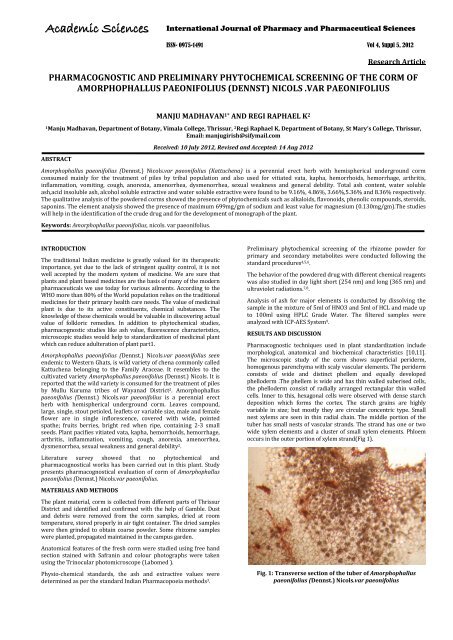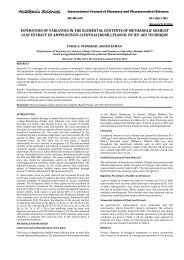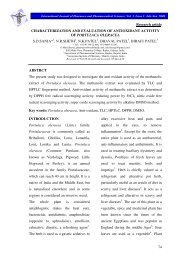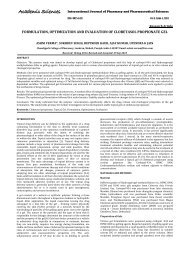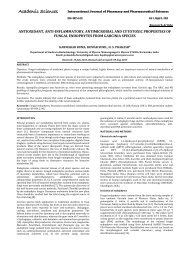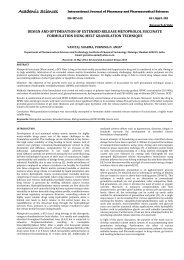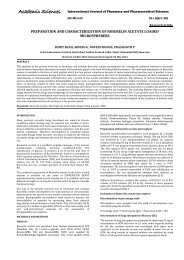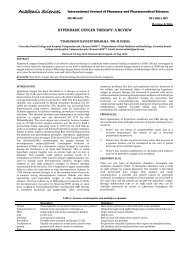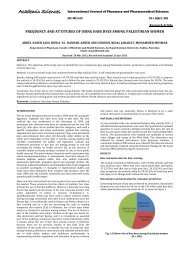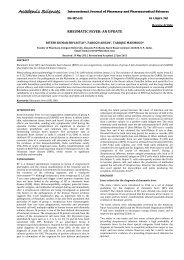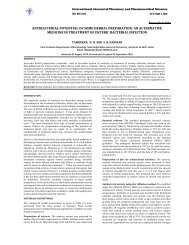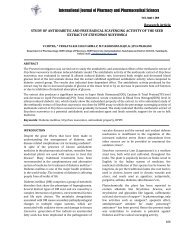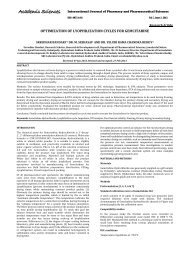(dennst) nicols.var paeonifolius - International Journal of Pharmacy ...
(dennst) nicols.var paeonifolius - International Journal of Pharmacy ...
(dennst) nicols.var paeonifolius - International Journal of Pharmacy ...
Create successful ePaper yourself
Turn your PDF publications into a flip-book with our unique Google optimized e-Paper software.
Academic Sciences<br />
Research Article<br />
PHARMACOGNOSTIC AND PRELIMINARY PHYTOCHEMICAL SCREENING OF THE CORM OF<br />
AMORPHOPHALLUS PAEONIFOLIUS (DENNST) NICOLS .VAR PAEONIFOLIUS<br />
MANJU MADHAVAN 1* AND REGI RAPHAEL K 2<br />
1Manju Madhavan, Department <strong>of</strong> Botany, Vimala College, Thrissur, 2Regi<br />
Raphael K, Department <strong>of</strong> Botany, St Mary’s College, Thrissur,<br />
Email: manjugirish@sifymail.com<br />
ABSTRACT<br />
Received: 10 July 2012, Revised and Accepted: 14 Aug 2012<br />
Amorphophallus <strong>paeonifolius</strong> (Dennst.) Nicols.<strong>var</strong> <strong>paeonifolius</strong> (Kattuchena) is a perennial erect herb with hemispherical underground corm<br />
consumed mainly for the treatment <strong>of</strong> piles by tribal population and also used for vitiated vata, kapha, hemorrhoids, hemorrhage, arthritis,<br />
inflammation, vomiting, cough, anorexia, amenorrhea, dysmenorrhea, sexual weakness and general debility. Total ash content, water soluble<br />
ash,acid insoluble ash, alcohol soluble extractive and water soluble extractive were found to be 9.16%, 4.86%, 3.66%,5.36% and 8.36% respectively.<br />
The qualitative analysis <strong>of</strong> the powdered corms showed the presence <strong>of</strong> phytochemicals such as alkaloids, flavonoids, phenolic compounds, steroids,<br />
saponins. The element analysis showed the presence <strong>of</strong> maximum 699mg/gm <strong>of</strong> sodium and least value for magnesium (0.130mg/gm).The studies<br />
will help in the identification <strong>of</strong> the crude drug and for the development <strong>of</strong> monograph <strong>of</strong> the plant.<br />
Keywords: Amorphophallus <strong>paeonifolius</strong>, <strong>nicols</strong>. <strong>var</strong> <strong>paeonifolius</strong>.<br />
INTRODUCTION<br />
The traditional Indian medicine is greatly valued for its therapeutic<br />
importance, yet due to the lack <strong>of</strong> stringent quality control, it is not<br />
well accepted by the modern system <strong>of</strong> medicine. We are sure that<br />
plants and plant based medicines are the basis <strong>of</strong> many <strong>of</strong> the modern<br />
pharmaceuticals we use today for <strong>var</strong>ious ailments. According to the<br />
WHO more than 80% <strong>of</strong> the World population relies on the traditional<br />
medicines for their primary health care needs. The value <strong>of</strong> medicinal<br />
plant is due to its active constituents, chemical substances. The<br />
knowledge <strong>of</strong> these chemicals would be valuable in discovering actual<br />
value <strong>of</strong> folkloric remedies. In addition to phytochemical studies,<br />
pharmacognostic studies like ash value, fluorescence characteristics,<br />
microscopic studies would help to standardization <strong>of</strong> medicinal plant<br />
which can reduce adulteration <strong>of</strong> plant part1.<br />
Amorphophallus <strong>paeonifolius</strong> (Dennst.) Nicols.<strong>var</strong> <strong>paeonifolius</strong> seen<br />
endemic to Western Ghats, is wild <strong>var</strong>iety <strong>of</strong> chena commonly called<br />
Kattuchena belonging to the Family Araceae. It resembles to the<br />
cultivated <strong>var</strong>iety Amorphophallus <strong>paeonifolius</strong> (Dennst.) Nicols. It is<br />
reported that the wild <strong>var</strong>iety is consumed for the treatment <strong>of</strong> piles<br />
by Mullu Kuruma tribes <strong>of</strong> Wayanad District2 . Amorphophallus<br />
<strong>paeonifolius</strong> (Dennst.) Nicols.<strong>var</strong> <strong>paeonifolius</strong> is a perennial erect<br />
herb with hemispherical underground corm. Leaves compound,<br />
large, single, stout petioled, leaflets or <strong>var</strong>iable size, male and female<br />
flower are in single inflorescence, covered with wide, pointed<br />
spathe; fruits berries, bright red when ripe, containing 2-3 small<br />
seeds. Plant pacifies vitiated vata, kapha, hemorrhoids, hemorrhage,<br />
arthritis, inflammation, vomiting, cough, anorexia, amenorrhea,<br />
dysmenorrhea, sexual weakness and general debility2. Literature survey showed that no phytochemical and<br />
pharmacognostical works has been carried out in this plant. Study<br />
presents pharmacognostical evaluation <strong>of</strong> corm <strong>of</strong> Amorphophallus<br />
<strong>paeonifolius</strong> (Dennst.) Nicols.<strong>var</strong> <strong>paeonifolius</strong>.<br />
MATERIALS AND METHODS<br />
The plant material, corm is collected from different parts <strong>of</strong> Thrissur<br />
District and identified and confirmed with the help <strong>of</strong> Gamble. Dust<br />
and debris were removed from the corm samples, dried at room<br />
temperature, stored properly in air tight container. The dried samples<br />
were then grinded to obtain coarse powder. Some rhizome samples<br />
were planted, propagated maintained in the campus garden.<br />
Anatomical features <strong>of</strong> the fresh corm were studied using free hand<br />
section stained with Safranin and colour photographs were taken<br />
using the Trinocular photomicroscope (Labomed ).<br />
Physio-chemical standards, the ash and extractive values were<br />
determined as per the standard Indian Pharmacopoeia methods<br />
<strong>International</strong> <strong>Journal</strong> <strong>of</strong> <strong>Pharmacy</strong> and Pharmaceutical Sciences<br />
ISSN- 0975-1491 Vol 4, Suppl 5, 2012<br />
3 .<br />
Preliminary phytochemical screening <strong>of</strong> the rhizome powder for<br />
primary and secondary metabolites were conducted following the<br />
standard procedures 4,5,6 .<br />
The behavior <strong>of</strong> the powdered drug with different chemical reagents<br />
was also studied in day light short (254 nm) and long (365 nm) and<br />
ultraviolet radiations. 7,8 .<br />
Analysis <strong>of</strong> ash for major elements is conducted by dissolving the<br />
sample in the mixture <strong>of</strong> 5ml <strong>of</strong> HNO3 and 5ml <strong>of</strong> HCL and made up<br />
to 100ml using HPLC Grade Water. The filtered samples were<br />
analyzed with ICP-AES System9. RESULTS AND DISCUSSION<br />
Pharmacognostic techniques used in plant standardization include<br />
morphological, anatomical and biochemical characteristics [10,11].<br />
The microscopic study <strong>of</strong> the corm shows superficial periderm,<br />
homogenous parenchyma with scaly vascular elements. The periderm<br />
consists <strong>of</strong> wide and distinct phellem and equally developed<br />
phelloderm .The phellem is wide and has thin walled suberised cells,<br />
the phelloderm consist <strong>of</strong> radially arranged rectangular thin walled<br />
cells. Inner to this, hexagonal cells were observed with dense starch<br />
deposition which forms the cortex. The starch grains are highly<br />
<strong>var</strong>iable in size; but mostly they are circular concentric type. Small<br />
nest xylems are seen in thin radial chain. The middle portion <strong>of</strong> the<br />
tuber has small nests <strong>of</strong> vascular strands. The strand has one or two<br />
wide xylem elements and a cluster <strong>of</strong> small xylem elements. Phloem<br />
occurs in the outer portion <strong>of</strong> xylem strand(Fig 1).<br />
Fig. 1: Transverse section <strong>of</strong> the tuber <strong>of</strong> Amorphophallus<br />
<strong>paeonifolius</strong> (Dennst.) Nicols.<strong>var</strong> <strong>paeonifolius</strong>
The ash values, total ash, acid insoluble ash and water soluble ash<br />
are particularly important in the evaluation <strong>of</strong> purity <strong>of</strong> drugs12 .<br />
Total ash content, water soluble ash,acid insoluble ash, alcohol<br />
soluble extractive and water soluble extractive were found to be<br />
9.16%, 4.86%, 3.66%,5.36% and 8.36% respectively. Ash and<br />
extractive values signify the amount <strong>of</strong> inorganic impurities,<br />
resistant materials like sand, soil and stone particles in crude drugs.<br />
The ash value <strong>of</strong> medicinal plants reflects the carbonate, phosphates,<br />
oxides, silicates and silica13 . Evaluation <strong>of</strong> ash and extractive values<br />
<strong>of</strong> crude drugs help in the identification and determination <strong>of</strong> its<br />
purity and quality14. Phytochemical analysis is very useful in the evaluation <strong>of</strong> active<br />
biological components <strong>of</strong> medicinal plants. The qualitative analysis<br />
Madhavan et al.<br />
Int J Pharm Pharm Sci, Vol 4, Suppl 5, 238-240<br />
<strong>of</strong> the powdered corms <strong>of</strong> Amorphophallus <strong>paeonifolius</strong> species<br />
showed the presence <strong>of</strong> phytochemicals such as alkaloids,<br />
flavonoids, phenolic compounds, steroids, saponins and the primary<br />
metabolites namely proteins, starch, carbohydrate(Table 1).<br />
Phytochemicals such as saponins, terpenoids, flavonoids, tannins,<br />
steroids and alkaloids have anti-inflammatory effects15<br />
. Presence <strong>of</strong><br />
phenols indicates the plant ability for antimicrobial activities16 . The<br />
good antioxidant activity and hypoglycemic activities can be<br />
attributed to the presence <strong>of</strong> flavonoids17 . Alkaloids acts as an<br />
analgesic drug18 . Alkaloids can increase nutrient absorption and<br />
blood circulation, hypoglycemic activities reduce pain and stimulate<br />
nerve system as it has narcotic effect19 . Saponins helps in controlling<br />
cholesterol, antidiabetic properties20 . The steroids and saponins are<br />
responsible for central nervous system activities21. Table 1: Preliminary screening <strong>of</strong> primary and secondary metabolites from Amorphophallus <strong>paeonifolius</strong> (Dennst.) Nicols.<strong>var</strong> <strong>paeonifolius</strong><br />
Primary/Secondary Metabolites Name <strong>of</strong> the Test Powdered tuber Observations<br />
Carbohydrates Fehling Test ++ Red ppt<br />
Starch Iodine Test +++ Blue colouration<br />
Sugar Antrone Reagent Test +++ Blue Black Colouration<br />
Proteins Lowry’s Method ++ Blue colouration<br />
Aminoacids Ninhydrin Test _ No violet or purple colour<br />
Fats Filter paper Test _ No oil stains on filter paper<br />
Quinone NaOH Test - No Red Colouration<br />
Cardiac glycoside Ferric Chloride Test - No green Blue ppt<br />
Steroids Liebermann-Burchard Test ++ Blue Green Ring<br />
Flavonoids Ethylacetate Test ++ Yellow colouration<br />
Phenols Folin Test +++ Blue coluration<br />
Saponins Foam Test ++ Froth appearence<br />
Alkaloids Ammoniacal test ++ Creamish PPt<br />
+ indicates the intensity <strong>of</strong> occurrence <strong>of</strong> the compound tested; - absence <strong>of</strong> metabolite<br />
Table 2: Flourescence analysis <strong>of</strong> powdered rhizome <strong>of</strong> Amorphophallus <strong>paeonifolius</strong> (Dennst.) Nicols.<strong>var</strong> <strong>paeonifolius</strong> .<br />
Powdered Drug Visible/Day light UV 254 nm (Short) UV 365 nm (LONG)<br />
Powder as such Light brown Black Black<br />
Powder + 1M NaOH Dark brown Black Dark blue<br />
Powder + 1% Picric Acid Light brown Black Dark blue<br />
Powder + Acetic acid Dark brown Black Grayish blue<br />
Powder + 1M HCl Dark brown Black Blackish blue<br />
Powder + 5% Iodine Creamish brown Black Dark blue<br />
Powder + 5% FeCl 3 Blackish brown<br />
Black black<br />
Powder + HNO 3 + 25% NH 3 Dark brown<br />
Black Blackish blue<br />
Powder + Methanol Dark brown Black Dark blue<br />
Powder + 50% HNO 3 Yellowish brown<br />
Black Dark blue<br />
Powder + 1M H 2SO 4 Dark brown<br />
Black black<br />
Powder +Conc HNO 3 Blackish brown<br />
Black Dark blue<br />
Powder + 10% potassium dichromate soln Yellowish brown Black black<br />
Powder + 25% Liquid NH3 Blackish brown<br />
Black Dark blue<br />
Fluorescence analysis is the phenomenon exhibited by <strong>var</strong>ious<br />
chemical constituents present in the plant material under UV<br />
light(Table 2). This can be used to characterise the crude drugs.<br />
Thus crude drug is <strong>of</strong>ten assessed qualitatively and this forms an<br />
important parameter <strong>of</strong> pharmacognostical evaluation.<br />
The data obtained for elemental concentrations <strong>of</strong> the plant tuber<br />
can be used to evaluate the potentiality <strong>of</strong> these in their medicinal<br />
preparations 22 .The analysis <strong>of</strong> element in the tuber (Table 3)<br />
indicated the presence <strong>of</strong> elements in the decreasing order with<br />
maximum value for Sodium and least value <strong>of</strong> Magnesium, Na<br />
>Fe>Sr>C>Mn>Cu>H>N>K>Ca>S>Mg. These elements play a vital<br />
role in the formation <strong>of</strong> secondary metabolites which are<br />
responsible for pharmacological actions <strong>of</strong> medicinal plants23. Sodium and potassium form the major essential elements and is<br />
present in the plant tuber. Sodium is necessary in production <strong>of</strong><br />
energy amino acid and glucose transport. A high concentration <strong>of</strong><br />
sodium is seen in the tuber <strong>of</strong> Amorphophallus. Magnesium<br />
represents the element with least concentration.Magnesium<br />
improves insulin sensitivity protect diabetes and its complications<br />
and reduce blood pressure.<br />
Table 3: Elements analysis <strong>of</strong> rhizome <strong>of</strong> Amorphophallus<br />
<strong>paeonifolius</strong> (Dennst.) Nicols.<strong>var</strong> <strong>paeonifolius</strong> .<br />
Elements Mg/g<br />
Nitrogen 2.48<br />
Carbon 41.59<br />
Sulphur 0.44<br />
Hydrogen 6.11<br />
Calcium 0.723<br />
Pottassium 0.939<br />
Magnesium 0.130<br />
Copper 19.35<br />
Iron 224.22<br />
Manganese 23.1<br />
Sodium 699.7<br />
Strontium 70.4<br />
239
Appreciable amount <strong>of</strong> manganese is found in the tubers. Manganese<br />
were found to be 28 mg/g <strong>of</strong> sample. Manganese deficiency causes<br />
skin damage anemia and hyper cholesterolemia 24 . Mn helps to<br />
reduce fatigue and reduces nervous irritability 25 .This plant can be<br />
used for medicinal preparations to supplement Mn for <strong>var</strong>ious body<br />
functions. Copper is an element actively involved in the synthesis <strong>of</strong><br />
haemoglobin and thus play a vital role in the control <strong>of</strong> anaemia . 19<br />
mg/g <strong>of</strong> copper is found in the tuber.Calcium which is essential<br />
element for life processes was found. Calcium overcome problems <strong>of</strong><br />
high blood pressure ,heart attack premenstrual syndrome ,colon<br />
cancer and keeping the bones strong[23].K is helpful in reducing<br />
hypertension and maintaining cardiac rhythum. Fe forms an<br />
essential element to prevent anemia. In human body the elements<br />
play vital role in many physiological reactions and their deficiency<br />
or excess can effect human health 26 .<br />
The scientific investigation <strong>of</strong> traditional herbal remedies may<br />
provide valuable tool for the development <strong>of</strong> alternative drug and<br />
therapeutic strategies27. The physicochemical parameters,<br />
preliminary phytochemical analysis,elemental analysis provide<br />
important information which may be help in authentication and<br />
adulteration for quality control <strong>of</strong> raw material.<br />
REFERENCES<br />
1. Abraham Z Glimpses <strong>of</strong> Indian Ethanobotany. Oxford<br />
2.<br />
&Publishing Co., New Delhi . 1981.308-320.<br />
Silja VP, Samitha Varma K, Mohanan KV Ethanomedicinal plant<br />
knowledge <strong>of</strong> Mulla Kuruma tribe <strong>of</strong> Wayanad District <strong>of</strong><br />
Kerala. Indian <strong>Journal</strong> <strong>of</strong> Traditional Knowledge. 2008; 7<br />
(4):604-612.<br />
3. Anonymous. India Pharmacopoeia Vol II, New Delhi, Controller<br />
<strong>of</strong> Publications Government <strong>of</strong> India . 1996.<br />
4. Kokate CK, Pharmacognosy. 16th Edn., Nirali Prakasham,<br />
Mumbai, India. 2009.<br />
5. Harborne JB, Phytochemical Methods. A guide to Modern<br />
Techniques <strong>of</strong> Plant Analysis. Champan &Hall. London. UK. 3<br />
Ed. 1998.<br />
6. Sadasivum, Manikam,Biochemical Methods. NewAge<br />
<strong>International</strong>(P)Limited. Publishers.2009.<br />
7. Gupta MK, Sharma PK, Ansari SH, Lagarkha R.,<br />
8.<br />
Pharmacognostical evaluation <strong>of</strong> Grewia asiatica fruits. Int. J<br />
Plant science. 2006 ;1 (2) :249-251.<br />
Kokashi CJ, Kokashi RJ,SharmaM, Flourescence <strong>of</strong> powedered<br />
vegetable drugs in ultra violet radiation. J. American Pharm.<br />
Assoc.1958; 47:715-717.<br />
9. Krachler M, Mohl C, Emons H, Shotyk, W, Spectrochim Acta.<br />
Part B. 2002; 57:1277-1289.<br />
10. Pramod V Pattar Jayaraj M Pharmacognostical and<br />
phytochemical investigation <strong>of</strong> Sida cordifolia L.A threatened<br />
medicinal herb <strong>International</strong> <strong>Journal</strong> <strong>of</strong> <strong>Pharmacy</strong> and<br />
Pharmaceutical Sciences,2011; 4(1): 114-117.<br />
11. Ravichandra V D,Padmaa M Paarakh Pharmacognostic and<br />
Phytochemical investigation on leaves <strong>of</strong> Ficus<br />
hispida,<strong>International</strong> <strong>Journal</strong> <strong>of</strong> <strong>Pharmacy</strong> and Pharmaceutical<br />
Sciences2011; 3( 2): 131-134.<br />
Madhavan et al.<br />
Int J Pharm Pharm Sci, Vol 4, Suppl 5, 238-240<br />
12. Shruthi, SD, Ramachandra YL,Padmalatha, Rai S, Prashant<br />
Kumar Jha, The Asian and Asian & Australasian J. Plant<br />
Sci. Biotech .2010;4(1). 62-65.<br />
13. Bharat Gami, Parabia MH, Pharmacognostic evaluation <strong>of</strong> Bark<br />
and seeds <strong>of</strong> Mimusops elengi <strong>International</strong> <strong>Journal</strong> <strong>Pharmacy</strong><br />
Pharmaceutical sciences.<br />
2010;2.(4):110-113.<br />
14. Kokate CK,Purohit AP,Gokhale SB, Pharmacognosy 45thEdition.<br />
Nirali prakashan,<br />
15. Mumbai India .2010.<br />
16. Ilkay Orhan, Esra Kupeli, Bilge Sener,Erdem Yesilada, Appraisal<br />
<strong>of</strong> anti – inflammatory potential <strong>of</strong> the clubmoss, Lycopodium<br />
clavatum L. J. Ethnopharmacol. 2007; 109:146-150<br />
17. Parekh Jigna,Sumitra ChandaV, Invitro antimicrobial<br />
activityand phytochemical analysis <strong>of</strong> some Indian medicinal<br />
plants. Turkish <strong>Journal</strong> <strong>of</strong> Biology. 2007;31.53-58.<br />
18. Cherian S, Augusti KT, Insulin sparing action <strong>of</strong><br />
leucopelargonidin derivative isolated from Ficus bengalesis<br />
Linn. Indian J. Exp. Biol, 1995;33: 608-611.<br />
19. Cowan MM, Plant products as antimicrobial agents, Clinical<br />
Microbiology Reviews 1999;12(4):564-582.<br />
20. Ong HC. Tumbuhan liar. Khasiat ubatan dan kegunaan lain.<br />
some Indian medicinal plants. J. Ethnopharmacol, 2004;19:<br />
425-428.<br />
21. Rupasinghe, HP, Jackson CJ, Poysa V, Di Berado C, Bewley JD,<br />
Jenkinson J, Soyasapogenol A and B distribution in Soybean<br />
(Glycine Max L.Merr)in relation to seed physiology, genetic<br />
<strong>var</strong>iability and growing location. J. Agric. Food Chem, 2003;51:<br />
5888-5894.<br />
22. Argal A, Pathak AK, CNS activity <strong>of</strong>Calotropis gigantea roots. J.<br />
Ethnopharmacology. 2006;106: 142-145<br />
23. Mamatha P, Sreevani P, Determination <strong>of</strong> sodium potassium<br />
chromium and Zinc in medicinal plants using instrumental<br />
neutron activation analysis (INAA). <strong>International</strong> <strong>Journal</strong> <strong>of</strong><br />
Pharmaceutical Research and Development, 2011.3(7): 165-<br />
169.<br />
24. Khan Kiran Yasmin, Mir Ajab Khan, Rabia Niamat,Mamoona<br />
Munir ,Hina Fazal,Paras Mazari,Nighat Seema,Tasmia<br />
Bashir,Ammarah Kanwal,Sidra Nisar Ahmed. Element content<br />
analysis <strong>of</strong> plants <strong>of</strong> genus Ficus using atomic absorption<br />
spectrometer. African <strong>Journal</strong> <strong>of</strong> <strong>Pharmacy</strong> and Pharmacology.<br />
2011 ,5(3) :317-321.<br />
25. Skenkin A, Clinical aspects <strong>of</strong> vitamin and trace element<br />
metabolism .Bailliere’s Clin. Gastroenter, 1998; 2:765-798.<br />
26. Djama AAD,Kouassi G<strong>of</strong>fri Mc,Koua AA,Ofosu FG,.Aboh IJK,<br />
Trace elements analysis <strong>of</strong> some antiparasitic medicinal plants<br />
in Cote d”ivoire using energy Dispersive X-ray Fluorescence<br />
(EDXRF) Technique. Current research <strong>Journal</strong> <strong>of</strong> Biological<br />
Sciences 2011;3(3): 209-215.<br />
27. Ekinci N,Ekinci R, Polat R,Budak G, Analysis <strong>of</strong> trace elements<br />
in medicinal plants with energy dispersive X-ray fluorescence. J<br />
Radio anal Nuclear Chemistry, 2004;260:127.<br />
28. Suriyavathana M,Usha V,Shanthanayaki M, Studies on<br />
phytochemical analysis and antioxidant activity <strong>of</strong> selected<br />
medicinal plants from kolli hills. <strong>Journal</strong> <strong>of</strong> <strong>Pharmacy</strong><br />
Research,2010; 3(2): 260-262.<br />
240


